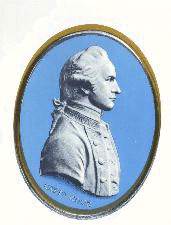
|
|
| CAPTAIN
JAMES COOK RN
|
|
|
| James Cook was born in the Yorkshire village of Marton on the 27th of October 1728.His father was a farm hand from Scotland.He was the second son of James and Grace Cook, who subsequently had five girls and another son. In 1736 the elder Cook was appointed bailiff to Airy Holme farm near Ayton. James had already been taught his letters by a charitable lady, one Mrs Walker. The young James cook was sent to High Green school Ayton, where he learned to write and the rudiments of Arithmetic. |

|
|
|
John Walker was one of the Walkers of Whitby, a well known firm of coal traders.While there, as was custom, James Cook lodged with his employer between voyages. He had his first voyage as an apprentice aboard the Whitby collier "Freelove". In 1755, after nine years and service as ship's master, Cook left his ship and enlisted in the Royal Navy as an able seaman aboard the 60-gun ship " Eagle ". In the Navy James Cook worked his way up through the ranks eventually rising to command his own survey vessel, unusual for an enlisted man. His first mission was to map the estuary of the St. Lawrence River prior to a naval assault on Quebec. |
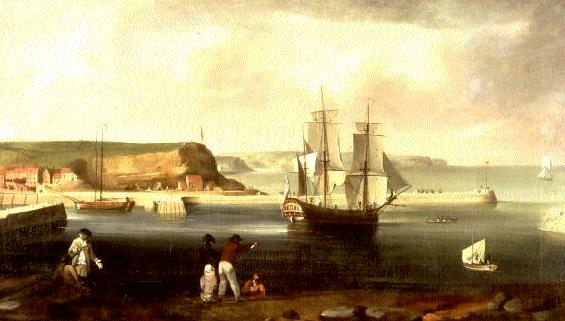
|
Earl of Pembroke off Whitby: Renamed HM Bark Endeavour |
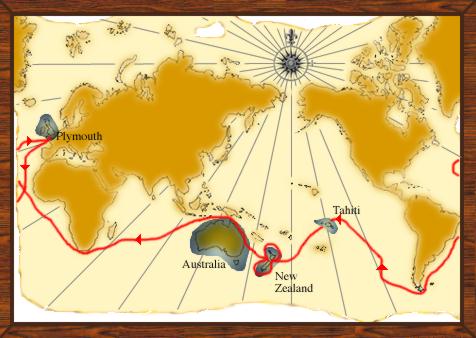
|
Cooks First Voyage |
|
Cook set out for his second voyage in the "Resolution" accompanied by Tobias Furneaux, commander of the
"Adventure", both ships built in Whitby by Fishburn." Resolution"
(formerly Drake) of 462 tons and the "Adventure" (formerly Raleigh) of 336 tons.
This time the voyage went by way of the Cape of Good Hope and far South, in a search for uncharted lands, until reaching New Zealand. Then eastward,again searching for land in the South, and then North to Tahiti. Again cook journeyed South crisscrossing the lower latitudes, even below the Polar Circle, in search of land until reaching New Zealand again. Again he pushed South across the Pacific, until he reached the endurance of his crew and went North to the Marquises Islands and Easter Island. Again from Tahiti he sailed West. He discovered many of the Tuamoutu Islands, Society Islands, Tonga and Fiji Islands until reaching what he named the New Hebrides. Sailing south he discovered New Caledonia. Cook returned to England and was " retired " to the Royal Hospital in Greenwich. Eventually a third voyage was planned. Cook was naturally consulted on the details of ships and men to do the job and just as naturally volunteered to do the job. The purpose of the third voyage was to seek out the elusive Northwest Passage (between the Atlantic and Pacific) from the pacific side. |
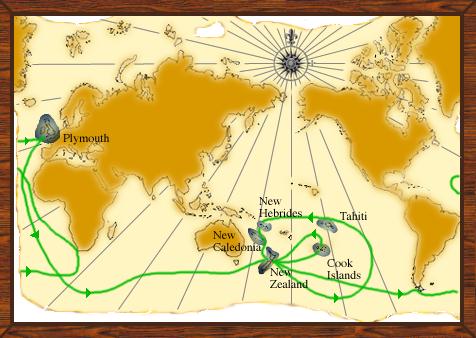
|
Cooks second Voyage |
|
Cook set out again from England with the "Resolution" with the company of Clerke in
"Discovery" (another Whitby cat 229 tons), and made for his usual landfall at New Zealand, confirming the location of Kerguelen Island on the way. From Tahiti he then sailed North, discovering what are now called the Cook Islands, to find the passage. He discovered Christmas Island and some of the smaller Hawaiian Islands, then proceeded to the northwest American coast and started charting and exploring. He eventually rounded the tip of the Alaska Peninsula, through the Bering Straits and into the Arctic Ocean where he
was impeded at every turn by ice. After spending as much time as he could, Cook turned South, to replenish and repair for the next year.
Cook had named Hawaii the Sandwich Islands, in honour of one of his patrons, John Montague the Earl of Sandwich. On the return voyage he spotted Maui on November 26, 1778. After eight weeks of seeking a suitable harbour the Discovery and Resolution finally found a safe anchorage at Kealakekua Bay on the Kona coast of the island of Hawaii. |
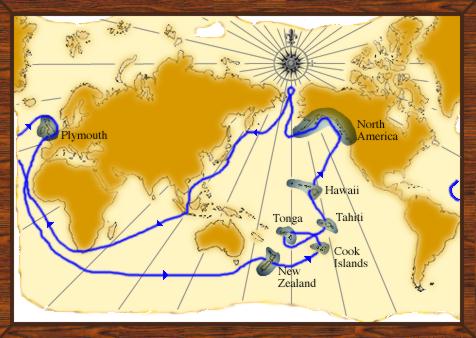 |
Cooks third and final voyage |
|
After an uproarious welcome and generous hospitality for over a month, it became obvious that the newcomers were beginning to over stay their welcome. Finally, the ships sailed away on February 4, 1779. After plying terrible seas for only a week, the fore mast on the Resolution was badly damaged and Cook sailed back into Kealakekua Bay, dragging the mast ashore on February 13th. The natives, now totally hostile, hurled rocks at the marines.
After a series of misunderstandings and skirmishes, Cook went ashore. The crowd around Cook and his men reached an estimated 20,000. One bold warrior advanced on Cook and struck him. The Hawaiians went wild. Hopelessly surrounded, Cook was knocked on the head, then countless warriors passed a knife around and hacked and mutilated his lifeless body. Four of the marines where killed with him and three dangerously wounded A sad Lt. King lamented in his diary, " Thus fell our great and excellent commander ". |
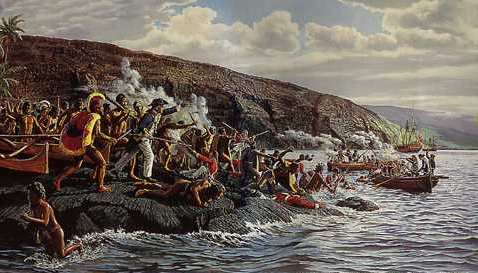
|
Death of Captain Cook |
|
After negotiations with the Hawaiians, Clerke, now in command, was able to have parts of Cook's body returned. The entire long bones, thighs, legs, arms and the skull - though the jawbone was missing. All had been scraped clean
of flesh and burned in a fire except some flesh from Cook's thigh, the scalp, and the hands. The hands were preserved with salt, and there were enough identifying marks (a scar between the thumb and forefinger of the right hand), that they were able to determine that it was Cook's body.
The remains were put into a coffin, and with great ceremony buried at sea in Kealakekua bay. Some men are the salt of the earth such a man was James Cook RN explorer. |
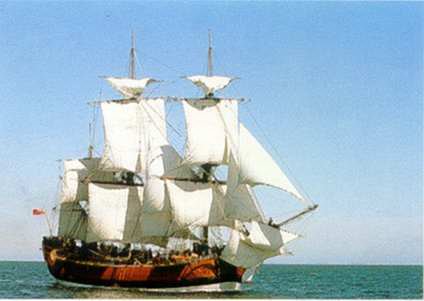
Australian built replica of HM Bark Endeavour
|